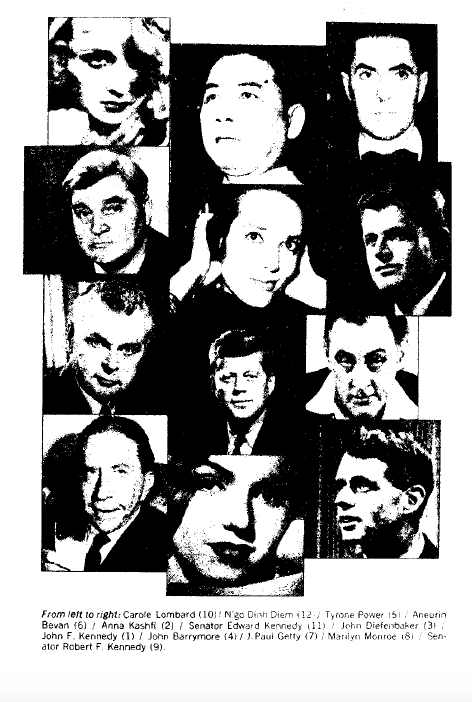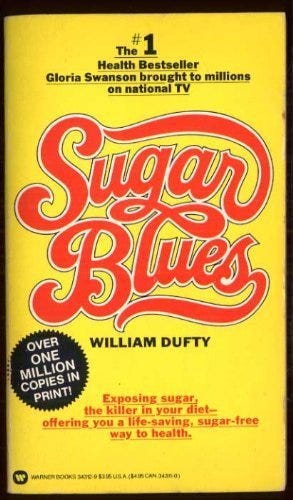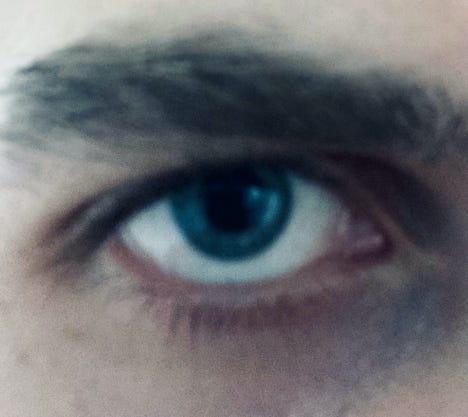“Don’t fire till you see the whites of their eyes!”
Col. Israel Putnam
It’s perhaps the one quote from the American Revolution you’ve used most, even if you didn’t know it. It’s certainly the revolutionary quote you used most as a kid, in neighborhood airsoft battles or afterschool search-and-destroy matches. It’s valiant advice, albeit a touch unsound. As J.L. Bell says in his history of the command, “No provincials literally waited until they could see the enemy’s eyeballs” to open fire. The quote likely gained traction in America’s popular imagination given that its badass tenor dignified an otherwise tough loss for the Revolutionary Army at the Battle of Bunker Hill, where Col. Israel Putnam famously issued the order.1
What’s baffling to me about the line isn’t its staying power in American culture, but the fact that it was ever said in the first place. Its audacious nature aside, the whites of one’s eyes (or, the sclera) aren’t typically a fixture of Western thought. We tend to focus more on the individualism ascribed to our irises. One thinks of the aesthetic adoration of grey eyes among the Pre-Raphaelites, or (of course) the Nazis’ fatal obsession with Aryan blue. The only time we ever find ourselves examining our sclera today is to ascertain the viciousness of a hangover or whether someone ripped one into our pillow. It’s too bad. If we’d actually heed Putnam’s advice the next time we look in the mirror, we might notice that the enemy is very close indeed. You could even say he’s already inside you.
Sanpaku, a Japanese term meaning “three whites,” was introduced to the West by a Japanese philosopher, dietician, Zen master, and (some say) prophet named Nyoichi Sakurazawa, better known in the West as Georges Ohsawa. Ohsawa rose to fame in the late sixties and early seventies for pointing out that many Americans have eyes that would’ve alarmed practitioners of traditional medicine in the Far East. The condition, which Ohsawa called sanpaku, can be diagnosed when a person has “three whites” bordering their irises—that is, when the sclera is visible both to the right and left of the iris as well as beneath.
According to Ohsawa, a healthy person’s iris should rest “below the eyelid like a rising sun.” The sanpaku condition, then, serves as a synecdoche for an afflicted state of being:
“Any sign of sanpaku meant that a man’s entire system—physical, physiological, and spiritual—was out of balance. He had committed sins against the order of the universe and he was therefore sick, unhappy, insane, what the West has come to call “accident prone.” The condition of sanpaku is a warning, a sign from nature, that one’s life is threatened by an early and tragic end.”2
Ohsawa, as you have already guessed, is an eccentric figure who is not without a certain charm. Born in Japan in 1893, he showed an interest from an early age in the concept of Macrobiotics, a form of “food education” that is less a diet than it is a philosophy of life. With roots in Zen Buddhism, Macrobiotics at its simplest stresses the importance of food to one’s physical, mental, and spiritual wellbeing. At its most extreme, it offers a full-blown historico-philosophical theory of East and West that claims the latter’s ills could largely be cured through embracing the “universal law” of Ancient Chinese thought. This theory, which Ohsawa calls In’yology, represents a return to Chinese thinking pre-5th century B.C., when, according to Ohsawa, “philosophy and science had already been perfected.”3
Though sanpaku is what he is most known for today, Ohsawa’s chief mission in life was sharing the ideas of Macrobiotics with the West. His first stop on this quest was France, where as an ambitious Japanese student he was perfectly suited to ride the coattails of japonisme to achieve a bit of local popularity. (His nom de plume, Ohsawa, is thought to derive from the common French response to “How are you?”…“Oh, ça va.”) His anecdotes about the miracle of Macrobiotics, which he claimed cured him of tuberculosis at 19, attracted enough attention for him to publish his first major work in French, The Unique Principle: The Philosophy of Macrobiotics, in 1931.
I finally found the book online after failing to access a hardcopy at NYU. (Despite its once mass popularity, the book is confined to the university’s non-circulating special collections.) It’s a fantastic read; I’ll put the link below. In it Ohsawa lays out discoveries he made during his intellectual pursuits. My favorite of the bunch should give you an idea of his style:
“All the great men, all the emperors, and all the ancient philosophers were incapable of perceiving light rays below 4900 or perhaps 4400 Angstroms. Therefore, they were blind to blue, indigo, and violet.”
There’s loads of this stuff packed in here, certainly enough to raise some eyebrows about the legitimacy of Macrobiotics. The fad might have flamed out like so many other mid-twentieth century Zen diets had it not been that in the sixties, after he had moved full-time to America, Ohsawa started to sound less like a quack philosopher-dietician and more like a 20th century prophet.
Let’s do a little crossword trivia:
What do the following 20th century figures have in common? (7 Letters)
Marilyn Monroe. Carol Lombard. Robert F. Kennedy. Former President of South Vietnam, N’go Dinh Diem. Former Iraqi revolutionary, Abd al-Karim Qasim. John F. Kennedy.
If you answered “TRAGEDY,” you’d have the right idea, wrong word. The correct answer? SANPAKU.
You Are All Sanpaku, University Books, 1965
In August 1963, Tom Wolfe, a relatively unknown journalist at the time, met a spritely Zen dietician-philosopher at the Wentworth Hotel in New York City. Spread in front of the mysterious man were photos of every figure listed above, including the current president, no doubt featured front and center. At one point in the conversation the man reflects broadly that Kennedy would “suffer many severe difficulties in the near future.” It’s not until Wolfe speaks with the man's lean, adoring followers that he gets the specifics: “the severe difficulty” the prophet foresees, they say, is “a tragic end.”4
The story runs in the New York Herald Tribune in August, 1963. Three months later the President is assassinated in Dallas. Part of the Warren Commission’s report concludes that an inability to react fast enough to Oswald’s first missed shot is part of what cost Kennedy his life. Kennedy, as we now know, was sanpaku. What’s the most debilitating effect of sanpaku according to Ohsawa’s quirky little book, published over thirty years before?
“When one is sanpaku, it means one has lost [the] ability to react instinctively—like an animal—to danger.”5
Plenty of amateur soothsayers, though, must’ve been contending for validation in the aftermath of Kennedy’s death, and it seems that initially little came of Ohsawa’s startling prediction. Tom Wolfe garnered most of the attention for the article, helping him go on to become, well, Tom Wolfe. Ohsawa meanwhile remained mostly obscure, living and teaching at the Ohsawa Foundation in New York, where he humbly dished out plates of unhusked brown rice and curious insights on the Ancients. That all changes in 1964, when a follow-up article Wolfe writes about Ohsawa catches the ailing sanpaku eyes of a writer named William Dufty.
Dufty is himself a wonderful character. Before discovering his own sanpaku condition, he had worked as a journalist and was primarily known for his relationship with Billie Holiday, whom his mother befriended while living in Harlem and who served (is that the right word?) as Dufty’s godmother. When Dufty read Wolfe’s article about JFK’s sanpaku and subsequently noticed that he too suffered from the condition, Dufty was himself ripe for personal transformation. “Like so many people past forty,” he writes, “I was not exactly sick yet I was far from being healthy.” Convinced by the portentous nature of his sanpaku, Dufty quickly adopts the Macrobiotics diet and begins reporting extraordinary results.
“The next few days brought a succession of wonders. Rectal bleeding stopped cold. Pink toothbrush—pyorrhea—“fini.” The texture and feel of my skin changed completely. I had gone ten days without an aspirin. I had quit perspiring. Cold February winds didn’t bother me. [...] After two weeks I weighed myself and discovered I had dropped from 193 to 173 pounds.”6
The changes don’t stop there. Over the next few weeks Dufty sheds a further twenty pounds and reports working harder than ever before. Then, Dufty suddenly falls into some legal trouble (what he vaguely calls “hopeless marital litigation”) and must spend 90 days in jail without the implements of his new miracle diet. No matter, his dietician at the Ohsawa Foundation tells him. “You’re macrobiotic for almost four months, you can go without food for thirty days at least with no danger at all.” Dufty only ends up spending 6 days in jail, but with the advice of his dietician he manages to shed a further twenty pounds, bringing his weight down to 133 lbs. “But I was in better shape than when I went in,” he says.
Much of what I was able to learn about Dufty comes from two books, You Are All Sanpaku (1965), which he co-wrote with Georges Ohsawa, and Sugar Blues (1975), an un-classifiable work of memoir/nutrition/philosophy that explores the debilitating effects of refined sugar on one’s health (the book was inspired by Dufty’s second wife, actress and notorious saccharophobe, Gloria Swanson). I have to admit: I love these books. Even if their medical advice skews towards quackery, I relish their form. The cover of Sugar Blues bills itself as a “Health Bestseller,” but the very first chapter, “It Is Necessary to be Personal,” is a touching account of Dufty’s childhood in rural Michigan and later love affair with Swanson, for whom an encounter with a sugar cube is likened to “Moses with a pork chop on his plate.”
Whatever happened to this sort of writing? Plenty of “miracle diets” still pop up in American culture, but their dissemination is mostly constricted to day-time television appearances or vile clickbait ads. This might seem like the rightful place for pseudoscience in our logical positivist discourse, but I can’t help feeling their loss. After all, it wasn’t really the diets that books like Ohsawa’s Zen Macrobiotics and Dufty’s Sugar Blues are all about. It’s the proposition, and really the freedom in proposing, that some Western habits are worth questioning. Dieting is perhaps the best way to introduce Americans to this kind of skepticism since it is one of the last forms of personal experimentation that we tolerate in the West, even in conservative circles. I know of no religion or ideology, even followed fundamentally, that would forbid one from consuming unhusked brown rice for six days or from refusing to take sugar with their tea.
And how much better if done so in the company of these books! Really they are quite unoffensive, even if they are unorthodox. Ohsawa’s central thesis, “You must heal yourself before attending to anything else,” finds coinage in most monotheistic belief systems, and Dufty’s personal narrative in Sugar Blues tempers his take down of capitalist profiteering in the food industry by allowing the reader to retain sentimental feelings about their sugar-rushed American youth.
Furthermore, such books provide an accessible portal for the general public to familiarize themselves with non-Western schools of thought. I concur with the comparatist philosopher Ben-Ami Scharfstein that it’s a lot to ask people raised in Western education systems to become fluent in amazingly rich non-Western intellectual traditions, like classical Indian or ancient Chinese philosophy.7 (My own education is illustrative here: I managed to graduate with a philosophy degree in 2019 without ever taking a single course on Eastern thought.) It’s imperative, however, that we make some study of such perspectives if for no other reason than to dispel the myth that China or India never developed philosophies relevant to modern life.
Today the opportunities for general engagement with Eastern thought seem to be shrinking, and intellectuals may be the ones most at fault. I fear that in forcing most forms of what I’ll call “naturopathy” to appear only in vapid, unsophisticated channels of culture we might have only exacerbated the plague of chicanery that this field is so susceptible too, while at the same time closing off an outlet that, though insufficient on its own, can lead to productive discussions of Eastern philosophy. Given that most of us cannot be primary scholars of such philosophy, only secondary ones, "health" books like Ohsawa's and Dufty's serve as decent starting points for kindling an interest in non-Western perspectives. For this reason alone perhaps it’s time we hand back some cultural currency to the these lovable kooks, so long as we agree to take their medical advice with a grain of salt (though, of course, hold the sugar).
Like all of you, the very first thing I did when I read about sanpaku was take a look at myself in the mirror. Ohsawa claims that 57th street and Fifth avenue is the “center of gravity for the sanpakus of the world.” I’m afraid that, even with the park between us, my brief time on the Upper West Side could not protect me from this gravitational effect. I too am sanpaku.
Not yet willing to commit to the rice cleanse, I took Dufty’s advice first and started with cutting out the sucrose. I too was raised with an American sweet tooth, particularly for ice cream before bed. The habit is doubly adverse for my health since it also kickstarts my IBS first thing every morning, which can create a living nightmare in my job as an elementary school teacher. I suffered for a few days on nightcaps of plums, which were ok, and sugar-free cookies, which sucked. Then one Saturday my wife and I took a trip down to Brighton Beach and visited the legendary Central Asian grocer, Tashkent Market, which has a superb selection of dried fruit. I loaded up on Turkish apricots and immediately started wolfing them down—the gooey interior and punch of natural sugars was exactly what I had been craving. I spent the rest of the day at my desk, writing and snacking in perfect bliss. Things only started to take a turn when my wife asked me to get her a chocolate bar at the bodega. I relented—she is not sanpaku—but armed with my apricots I was no longer envious of her treat.
Fifteen minutes later I stepped out of Martinez grocery and felt an ominous stir. I paused, ascertained. Oh God. I was two blocks away. I began walking quickly, but this only made my condition more precarious. A public bathroom at Carroll Park appeared to my right but I moved right past it, not thinking. When one is sanpaku, it means one has lost the ability to react instinctively—like an animal—to danger. With a block left I started to jog, then sprint to our door. I was less than fifty yards away when…it happened. Yes. I believe a grown man ought to be honest with himself and the world about such things. I shit my pants. Fine, honestly not the first time it’s happened even this year, but this accident was made a good deal worse given that a neighbor opened their front door and began introducing themselves to me exactly at my moment of weakness. They’d just moved to the neighborhood, daughter enrolled at my school, let me get her she’ll be so thrilled. Oh no that’s quite all—hello there, yes, I’m Mr. Fritz. Excited for the school year, yes. Maybe she’ll be in your class? Oh, wow, wouldn’t that be, uh, serendipitous.
No matter. While the diet may have failed me, in reading Ohsawa I had come across this comforting line from Lao-Tzu in Tao Te Ching.
“Everyone knows that the soft and yielding overcomes the rigid and hard, but few can put this knowledge into practice.”
In accepting that a rigid diet likely wouldn’t cure my IBS (or, at least, that hoovering a pound of dried apricots wasn’t exactly a miracle cure), I had come to a kind of peace with my condition. All that was left for me to do was what fellow sanpaku John Lennon says on his album Mind Games.
“When I’m down real sanpaku
And I don’t know what to do
Aisumasen Aisumasen Yoko san
All I had to do was call your name.”8
Ohsawa, Ohsawa, I repeated like a mantra, stumbling the rest of the way home.
Oh, ça va.
J.L. Bell, “Who Said “Don’t Fire Till You See the Whites of Their Eyes”?” Journal of the American Revolution, June 17, 2020 https://allthingsliberty.com/2020/06/who-said-dont-fire-till-you-see-the-whites-of-their-eyes/
Sakurazawa Nyoiti, You Are All Sanpaku (University Books, 1965), 70.
Georges Ohsawa, Unique Principle: Philosophy of Macrobiotics (www.ohsawamacrobiotics.com)
Tom Wolfe, “Kennedy to Bardot, Too Much Sanpaku,” New York Herald Tribune August 18, 1963.
You Are All Sanpaku, 56.
Ibid., 24
Ben-Ami Scharfstein, The Nonsense of Kant and Lewis Carroll, 5.
John Lennon, “Aisumasen (I’m Sorry),” Mind Games (1973).








Honestly shocked to find out after a sprint to the bathroom mirror that I am not sanpaku (still plenty wrong behind the whites of these -7.0 prescripsh eyes, though, I assure you).
Also, I second David--truly great work. Love the way you write, dude. Thanks for sharing, very excited for what’s to come in the Arizona Room.
This was a wild ride. Awesome work.